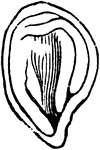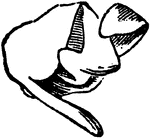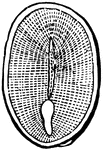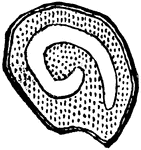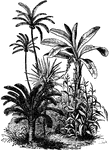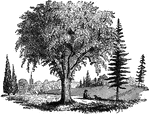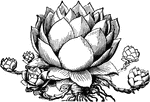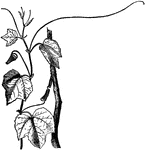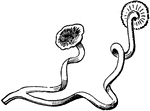Silver Maple Key
Fruit of Silver Maple, Acer dasycarpum, of natural size, the seed-bearing portion divided to show seed.
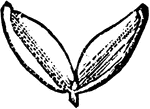
Silver Maple Seed Open
Silver Maple seed open out, to show the thick cotyledons and the little plumule or bud between them.

Germination of Silver Maple
Germination of Silver Maple, natural size; merely the base of the fruit, containing the seed, is shown.

Common Bean Seedling
Caulicle well lengthened and root beginning; thick cotyledons partly spreading; plumule (pair of leaves)…

Beech-nut Germination
Beginning germination of the Beech, showing the plumule growing before the cotyledons have opened or…
Beech-nut Germination Older
Older beech with the plumule-leaves developing, and elevated on a long internodes.

Pea Embryo
Embryo of pea, i.e. a pea with the coats removed; the short and thick caulicle presented to view.
Pea Germination
Pea germination: the plumule has developed four or five internodes, bearing single leaves; but the first…
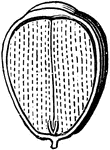
Acorn
Half of an acorn, cut lengthwise, filled by the very thick cotyledons, the base of which encloses the…
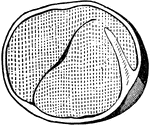
Horse Chestnut
Half of a horse-chestnut, similarly cut; the caulicle is curved down on the side of one of the thick…

Horse Chestnut in Germination
Horse-chestnut in germination; footstalks are formed to the cotyledons, pushing out in their lengthening…
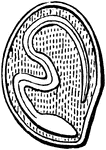
Morning Glory Seed
Seed of Morning Glory divided, moderately magnified; shows a longitudinal section through the centre…

Acanthus
A genus of plants or shrubs, mostly tropical, two species of which arecharacterized by large white flowers…
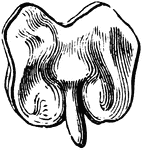
Morning Glory Embryo
Embryo taken out whole and unfolded; the broad and very thin cotyledons notched at summit; the caulicle…
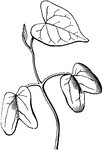
Morning Glory Seedling
Seedling of Morning Glory more advanced (root cut away); cotyledons well developed into foliage-leaves:…

Mirabilis
Section of the seed of Mirabilis or Four-o'clock, showing the embryo coiled round the outside of the…

Section of Pine-seed
Section of a Pine-seed, showing its polycotyledonous embryo in the centre of the albumen; moderately…

Seedling of Pine-seed
Seedling of pine-seed, showing the freshly expanded six cotyledons in a whorl, and the plumule just…

Flower-de-Luce
Section of a seed of the Iris, or Flower-de-Luce, enlarged, showing its small embryo in the albumen,…
Iris Germinating
A germinating seedling of the Iris, its plumule developed into the first four leaves (alternate), the…
Shoot of Horse-chestnut
Shoot of Horse-chestnut, of one year's growth, taken in autumn after the leaves have fallen; showing…

Auxiliary Bud
An auxiliary bud, concealed under the hollowed base of the leafstalk, in Buttonwood or Plane-tree.
Shoot of Lilac
Shoot of Lilac, with winter buds; the two uppermost auxiliary ones strong; the terminal not developed.
Red-Maple branch
Red-Maple branch, with accessory buds placed side by side. The annular lines toward the base are scars…

Maple Seedling
Seedling Maple, of the natural size; the root well supplied with root hairs, here large enough to be…

End of Maple Root
Lower end of Maple root magnified, the root seen just as root-hairs are beginning to for a little behind…
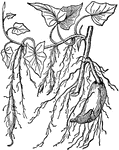
Sweet-Potato
Sweet-Potato plant forming thickened roots. Some in the middle are just beginning to thicken; one at…

Epiphytes of Florida and Georgia
Epidendrum conopseum, a small Orchid, and Tillandsia usneoides, the so-called Long Moss or Black Moss,…

Yellow Gerardia
Roots of Yellow Gerardia, some attached to and feeding on the root of Blueberry-bush.

Honey Locust
A branching thorn of Honey Locust, being an indurate leafless branch developed from an accessory bud…
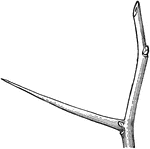
Cockspur Thorn
Spine of Cockspur Thorn developed from an auxiliary bud, as the leaf-scar below witnesses: an accessory…

Solomon's Seal
Rootstock of Solomon's Seal, with the bottom of the stalk of the season, and the bud for the next year's…
